



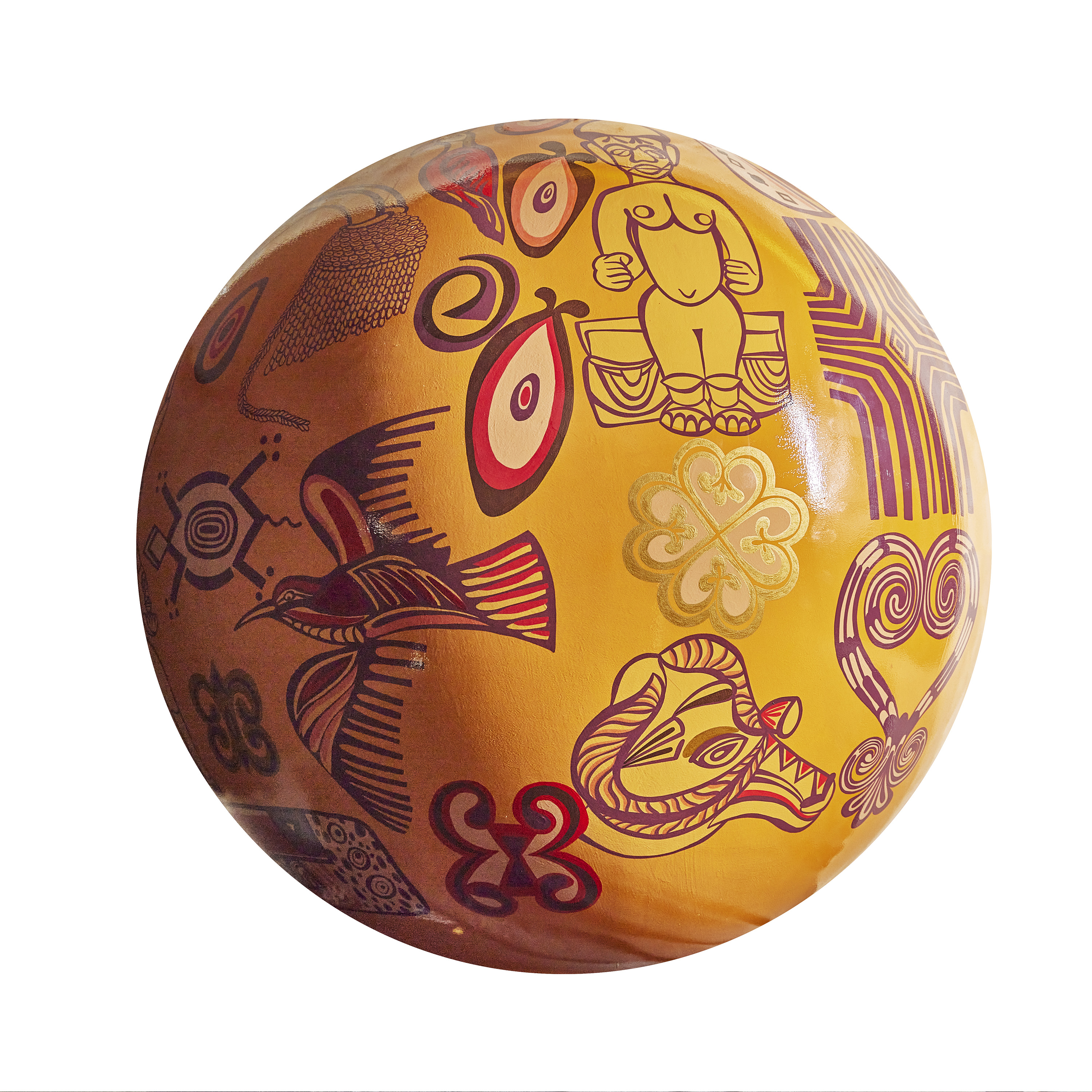
The Spirit Of CultureMy design responds to the theme of Mother Africa and is a celebration of African culture, spirituality, tradition, craftsmanship, communities and history and is focused on the period before the Transatlantic Trade in Enslaved Africans. I worked with closely with the collections at the Inter... |
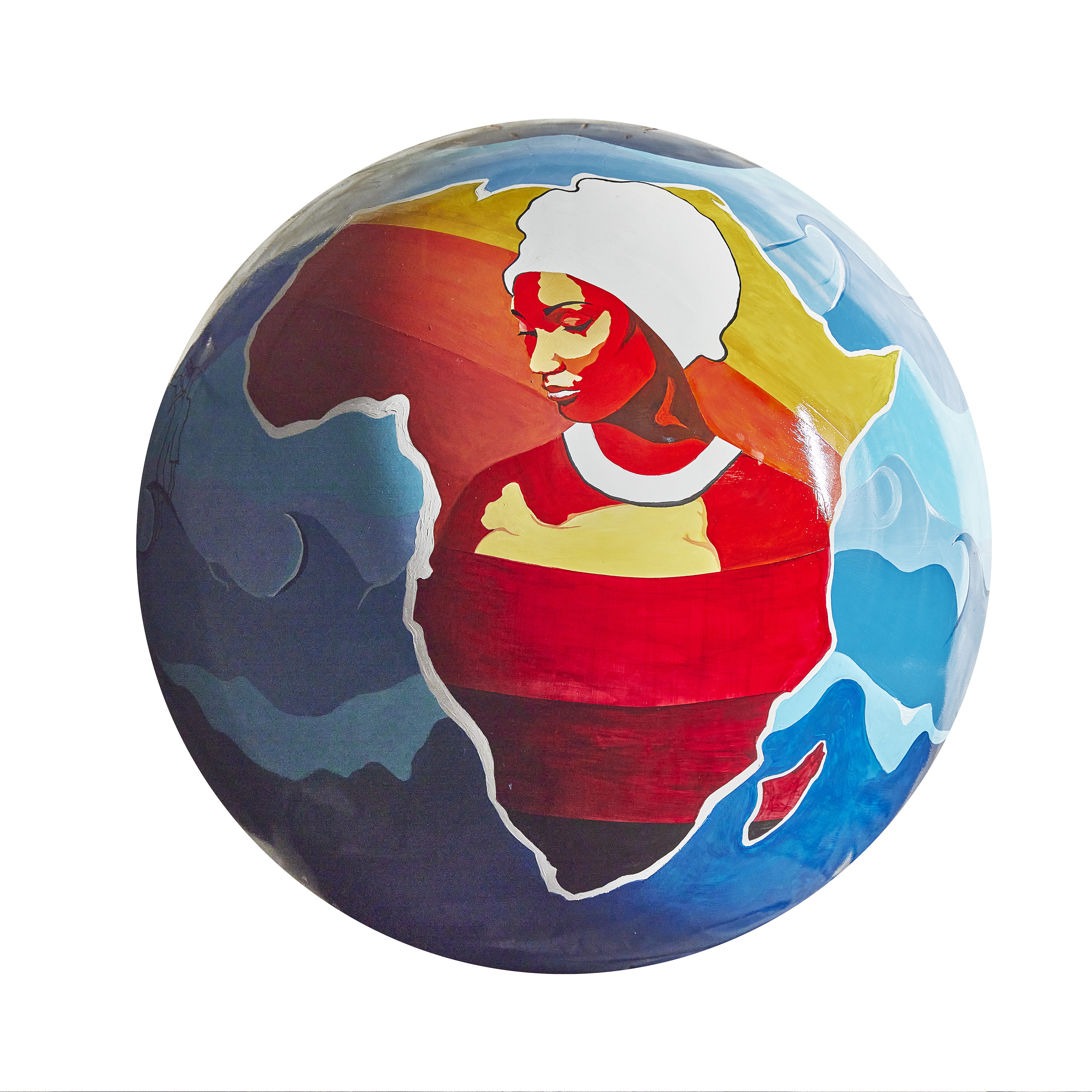
The Leicester Community GlobeOur community workshop took place, fittingly, at the African Caribbean Centre in Leicester. It is a place for this community to be together. It offered us a familiar environment to discuss the history of Leicester’s black community. In my d... |
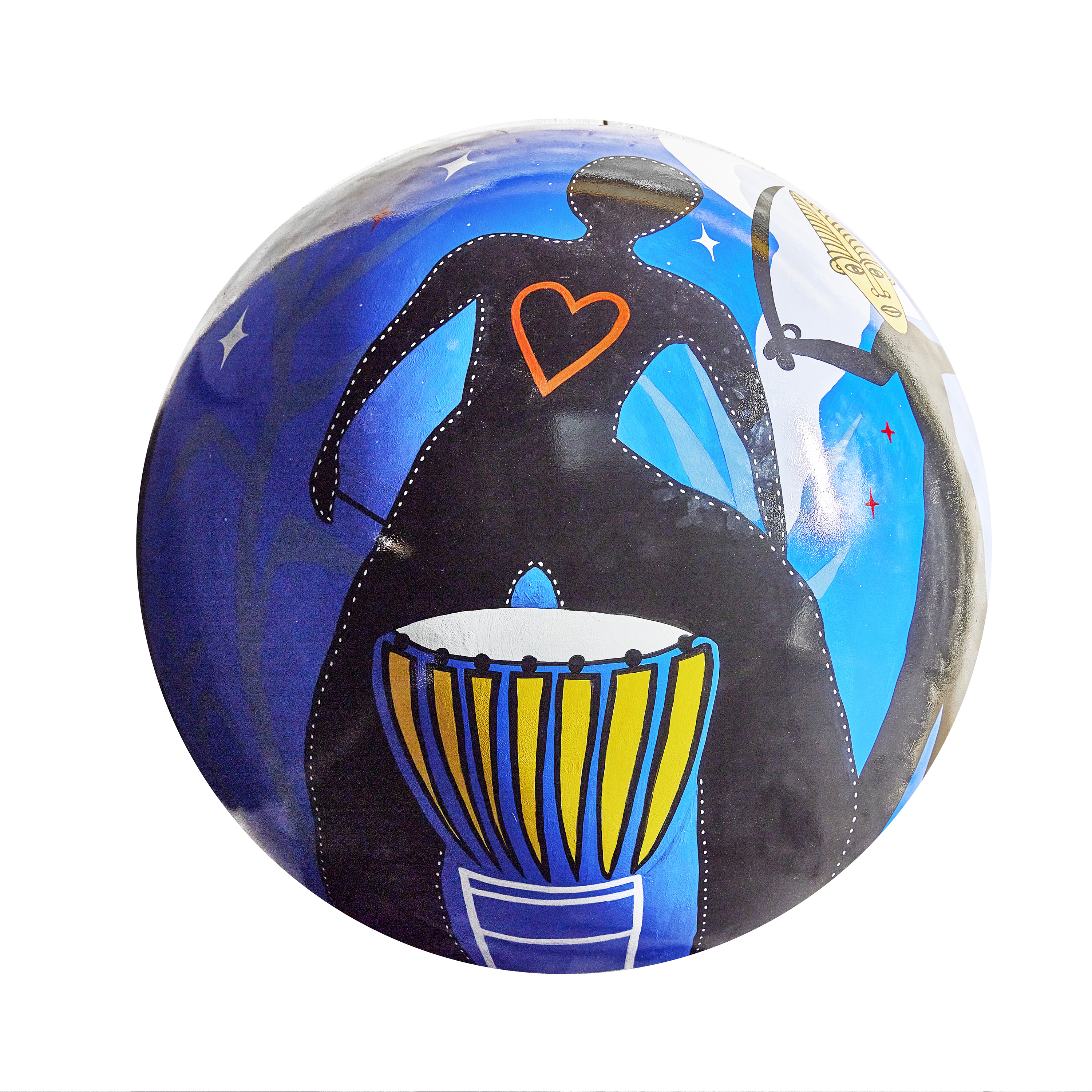
Ancestral ConnectionsWhen we think of the word ‘legacy’ we often think of it in terms of inherited money or property. In the context of the Transatlantic Trade in Enslaved Africans it usually represents money which has been made by European nations off... |
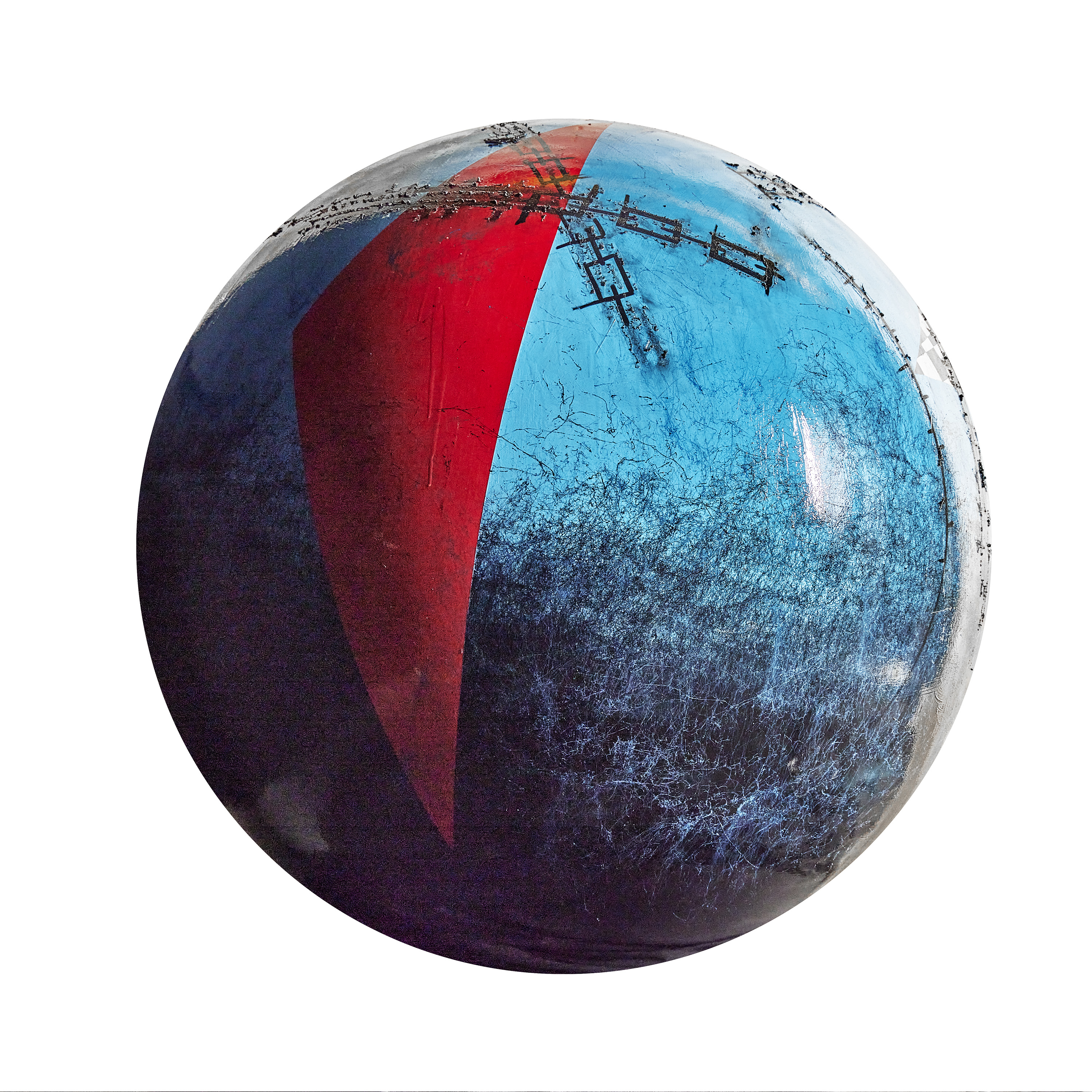
The Emancipation GlobeThis design is made up of gunpowder chains that were ignited to scorch their surrounding area, an example of this method, which I often use. The base of the globe is painted in 'vanta black' the darkest substance known to humans as this represent... |

Staying PowerColonialism comes in many different forms but is essentially about an encroachment on other people’s space. My work is about resisting these forces which infringe upon lands, bodies, minds and souls that are not theirs. A reference I often return to in my work is the struggle fought a... |


| Leicester Station, London Road, LE2 0DB |
Laura-Kate's design responds to the theme ‘Mother Africa’, which explores the richness and reality of Africa before the Transatlantic Trade in Enslaved Africans; the impact of the Transatlantic Trade in Enslaved Africans and European colonialism on Africa; and considers and celebrates Africa’s present and future.
My design responds to the theme of Mother Africa and is a celebration of African culture, spirituality, tradition, craftsmanship, communities and history and is focused on the period before the Transatlantic Trade in Enslaved Africans. I worked with closely with the collections at the International Slavery Museum between 2014 and 2019 creating artwork, learning worksheets and workshops.
This design is inspired by the West African collection held at the museum and features cultural artefacts, tools, ceremonial objects, Adinkra symbols and decorative designs from their reconstruction of an Igbo compound.
I hope that my design shines a light on the anthropological significance held by these objects, motifs and artefacts as well as the rich cultural heritage of West Africa before the atrocities born out of the Transatlantic Trade in Enslaved Africans affected this region.
I am obsessional about colour and pattern; as a result my work is an exploration of meticulous detail and an explosion of bright colour. Things I love illustrating – animals and wildlife, allowing me to indulge in my passion for the environment & natural science, as well as whiling away the hours creating curious characters interwoven with whimsical narratives. Above all else I enjoy drawing and creating work that allows me to escape into the world of my imagination, a place that makes me smile and in turn I hope makes others smile too.
http://www.laura-katedraws.co.uk
Laura-Kate's design responds to the theme ‘Mother Africa’, which explores the richness and reality of Africa before the Transatlantic Trade in Enslaved Africans; the impact of the Transatlantic Trade in Enslaved Africans and European colonialism on Africa; and considers and celebrates Africa’s present and future.
My design responds to the theme of Mother Africa and is a celebration of African culture, spirituality, tradition, craftsmanship, communities and history and is focused on the period before the Transatlantic Trade in Enslaved Africans. I worked with closely with the collections at the International Slavery Museum between 2014 and 2019 creating artwork, learning worksheets and workshops.
This design is inspired by the West African collection held at the museum and features cultural artefacts, tools, ceremonial objects, Adinkra symbols and decorative designs from their reconstruction of an Igbo compound.
I hope that my design shines a light on the anthropological significance held by these objects, motifs and artefacts as well as the rich cultural heritage of West Africa before the atrocities born out of the Transatlantic Trade in Enslaved Africans affected this region.
I am obsessional about colour and pattern; as a result my work is an exploration of meticulous detail and an explosion of bright colour. Things I love illustrating – animals and wildlife, allowing me to indulge in my passion for the environment & natural science, as well as whiling away the hours creating curious characters interwoven with whimsical narratives. Above all else I enjoy drawing and creating work that allows me to escape into the world of my imagination, a place that makes me smile and in turn I hope makes others smile too.
http://www.laura-katedraws.co.uk


| Victoria Park, Granville Road. LE1 7RY |
The work of making racial justice a reality must be rooted in community – in our individual and collective experiences, hopes and contributions. Natasha’s design was created in response to dialogue and workshops with local communities.
Our community workshop took place, fittingly, at the African Caribbean Centre in Leicester. It is a place for this community to be together. It offered us a familiar environment to discuss the history of Leicester’s black community. In my design I represent these two demographics, African and Caribbean, through the images of two women.
On one side I highlight Leicesters vibrant African community with Mama Africa, a strong and beautiful woman surrounded by rich earth tones to represent the land. On the other side of the globe, I feature a Caribbean woman with a waterfall of braids that carries some of the important people and places of Leicester’s Caribbean community.
Between them I have painted the background blue representing the ocean that separates these two communities today. Despite the physical distance these two groups are connected by the history of the Transatlantic Trafficing of Enslaved Africans. We honour their roots.
Natasha Muluswela b. 1995 is a self-taught, Zimbabwean-born visual artist based in the United Kingdom. Muluswela studied French and Spanish at Nottingham Trent University, graduating in 2017. Her art centers around body positivity, exploring what it means to be deemed as beautiful in our society. She explores skin conditions such as vitiligo, stretch marks and ageism. Conditions which in some parts of the world are seen as shameful or have stigma tied to them.
Muluswela wants to portray how society can deem these as imperfections. Yet to her, these unique markings are a natural part of being human. Additionally, Muluswela’s works explore the human condition of migration and what it means for Africans to take-up space away from the Diaspora. Through the use of symbolism through figures, she sheds light on the deep-rooted realities of racism, discrimination and marginalisation in a post-colonial oppressive system. Challenging her views on not only Africa’s political past and present but its potential and future through art. The subject matter of each artwork determines the materials used in the piece.
The work of making racial justice a reality must be rooted in community – in our individual and collective experiences, hopes and contributions. Natasha’s design was created in response to dialogue and workshops with local communities.
Our community workshop took place, fittingly, at the African Caribbean Centre in Leicester. It is a place for this community to be together. It offered us a familiar environment to discuss the history of Leicester’s black community. In my design I represent these two demographics, African and Caribbean, through the images of two women.
On one side I highlight Leicesters vibrant African community with Mama Africa, a strong and beautiful woman surrounded by rich earth tones to represent the land. On the other side of the globe, I feature a Caribbean woman with a waterfall of braids that carries some of the important people and places of Leicester’s Caribbean community.
Between them I have painted the background blue representing the ocean that separates these two communities today. Despite the physical distance these two groups are connected by the history of the Transatlantic Trafficing of Enslaved Africans. We honour their roots.
Natasha Muluswela b. 1995 is a self-taught, Zimbabwean-born visual artist based in the United Kingdom. Muluswela studied French and Spanish at Nottingham Trent University, graduating in 2017. Her art centers around body positivity, exploring what it means to be deemed as beautiful in our society. She explores skin conditions such as vitiligo, stretch marks and ageism. Conditions which in some parts of the world are seen as shameful or have stigma tied to them.
Muluswela wants to portray how society can deem these as imperfections. Yet to her, these unique markings are a natural part of being human. Additionally, Muluswela’s works explore the human condition of migration and what it means for Africans to take-up space away from the Diaspora. Through the use of symbolism through figures, she sheds light on the deep-rooted realities of racism, discrimination and marginalisation in a post-colonial oppressive system. Challenging her views on not only Africa’s political past and present but its potential and future through art. The subject matter of each artwork determines the materials used in the piece.


| Medway Community Primary School, Upper Tichborne Street, LE2 1GH |
Lou's design responds to the theme ‘Stolen Legacy: The Rebirth of a Nation’, which brings to life how Britain was transformed and enriched as a result of the Transatlantic Trade in Enslaved Africans and the free labour of the enslaved. It explores the legacy of the Transatlantic Trade in Enslaved Africans in building the financial and trading power of Britain; strengthening the Church and the might of universities; and establishing dynastic influence and power.
When we think of the word ‘legacy’ we often think of it in terms of inherited money or property. In the context of the Transatlantic Trade in Enslaved Africans it usually represents money which has been made by European nations off of the back of slavery.
There is another side to this topic though – the human side – the legacy that is part of a person’s history. These are things that remain from an earlier time: customs and traditions that are passed down through society and families – the precious legacies that shape us all as people. The Transatlantic Trade in Enslaved Africans robbed many African people of their ancient customs and traditions once they became enslaved.
For example, drumming – an integral part of African culture – was forbidden by the plantation owners who were fearful of the practice and saw it as a means of cultural resistance. In Barbados in the 1600s they even instituted a law to outlaw the playing of drums, with one of the penalties being death.
In response to this the enslaved people began adapting their African derived music to sound like that of the Europeans (making drums out of local materials to substitute for those they had left behind in West Africa) and these bands became known in Barbados as Tuk bands (which still feature in Barbados modern culture today) – ‘tuk’ being derived from the Scottish word ‘touk’, meaning to beat or sound an instrument. They also played these instruments as a form of rebellion.
With my design I wanted to feature the strength, resilience and adaptability of the enslaved people as they tried to keep hold of their customs whilst dealing with the reality of living and working in inhumane conditions thousands of miles and worlds apart from the homes, families and lives they were forced to leave behind.
Lou is a mixed media artist from Bristol, UK. She is also a proud citizen of Barbados (her husband’s place of birth).
Lou’s work, which ranges from drawing and painting to graphic design and printmaking, reflects her love for bold design and striking colour and she is heavily influenced by the great local street art and music scenes that her home city is famous for.
Lou is also inspired by Bristol's diverse mix of cultures and the sights and sounds of urban life. She also loves to seek inspiration when spending time in Barbados with her family.
Lou is self-taught and enjoys working with a variety of mediums. She loves experimenting and learning new techniques and has recently developed a style that has enabled her to combine some of the design characteristics of screen printing, stencil spray painting, collage and sketching in order to digitally produce some new, multi-layered giclee prints. Lou has also started undertaking some private mural commissions, examples of which can be found on her website.
Lou's design responds to the theme ‘Stolen Legacy: The Rebirth of a Nation’, which brings to life how Britain was transformed and enriched as a result of the Transatlantic Trade in Enslaved Africans and the free labour of the enslaved. It explores the legacy of the Transatlantic Trade in Enslaved Africans in building the financial and trading power of Britain; strengthening the Church and the might of universities; and establishing dynastic influence and power.
When we think of the word ‘legacy’ we often think of it in terms of inherited money or property. In the context of the Transatlantic Trade in Enslaved Africans it usually represents money which has been made by European nations off of the back of slavery.
There is another side to this topic though – the human side – the legacy that is part of a person’s history. These are things that remain from an earlier time: customs and traditions that are passed down through society and families – the precious legacies that shape us all as people. The Transatlantic Trade in Enslaved Africans robbed many African people of their ancient customs and traditions once they became enslaved.
For example, drumming – an integral part of African culture – was forbidden by the plantation owners who were fearful of the practice and saw it as a means of cultural resistance. In Barbados in the 1600s they even instituted a law to outlaw the playing of drums, with one of the penalties being death.
In response to this the enslaved people began adapting their African derived music to sound like that of the Europeans (making drums out of local materials to substitute for those they had left behind in West Africa) and these bands became known in Barbados as Tuk bands (which still feature in Barbados modern culture today) – ‘tuk’ being derived from the Scottish word ‘touk’, meaning to beat or sound an instrument. They also played these instruments as a form of rebellion.
With my design I wanted to feature the strength, resilience and adaptability of the enslaved people as they tried to keep hold of their customs whilst dealing with the reality of living and working in inhumane conditions thousands of miles and worlds apart from the homes, families and lives they were forced to leave behind.
Lou is a mixed media artist from Bristol, UK. She is also a proud citizen of Barbados (her husband’s place of birth).
Lou’s work, which ranges from drawing and painting to graphic design and printmaking, reflects her love for bold design and striking colour and she is heavily influenced by the great local street art and music scenes that her home city is famous for.
Lou is also inspired by Bristol's diverse mix of cultures and the sights and sounds of urban life. She also loves to seek inspiration when spending time in Barbados with her family.
Lou is self-taught and enjoys working with a variety of mediums. She loves experimenting and learning new techniques and has recently developed a style that has enabled her to combine some of the design characteristics of screen printing, stencil spray painting, collage and sketching in order to digitally produce some new, multi-layered giclee prints. Lou has also started undertaking some private mural commissions, examples of which can be found on her website.


| The Highfields Centre, Melbourne Road, LE2 0DS |
Marcus' design responds to the theme ‘Abolition & Emancipation’, which shares the story of the campaign for abolition, its key events, heroes and allies. It also lays bare the full, messy motivations and process of abolition, which were not as pure as often represented.
This design is made up of gunpowder chains that were ignited to scorch their surrounding area, an example of this method, which I often use. The base of the globe is painted in 'vanta black' the darkest substance known to humans as this represents one of the darkest times in human history.
Rising out of the darkness are emancipated chains and block shapes in red which represent the bloodshed and sacrifices which lead to freedom. Pieces missing depicted by the grid shape in the background are there to remind us that there will always be unfulfilled potential and people missing due to the atrocities of slavery.
All of this is based on a background of blues, which are the inverted colours to black, representing African skin tones. This inversion represents incarceration and slavery which is the exact opposite to freedom that the people of the time should have been experiencing.
Marcus Dove’s main artistic focus is utilising pyrotechnics and other exothermic materials like gunpowder and smoke grenades in order to communicate the process of ‘creation via destruction’. He predominantly works large-scale on canvas to produce figurative narratives.
Marcus' design responds to the theme ‘Abolition & Emancipation’, which shares the story of the campaign for abolition, its key events, heroes and allies. It also lays bare the full, messy motivations and process of abolition, which were not as pure as often represented.
This design is made up of gunpowder chains that were ignited to scorch their surrounding area, an example of this method, which I often use. The base of the globe is painted in 'vanta black' the darkest substance known to humans as this represents one of the darkest times in human history.
Rising out of the darkness are emancipated chains and block shapes in red which represent the bloodshed and sacrifices which lead to freedom. Pieces missing depicted by the grid shape in the background are there to remind us that there will always be unfulfilled potential and people missing due to the atrocities of slavery.
All of this is based on a background of blues, which are the inverted colours to black, representing African skin tones. This inversion represents incarceration and slavery which is the exact opposite to freedom that the people of the time should have been experiencing.
Marcus Dove’s main artistic focus is utilising pyrotechnics and other exothermic materials like gunpowder and smoke grenades in order to communicate the process of ‘creation via destruction’. He predominantly works large-scale on canvas to produce figurative narratives.


| Stephen Lawrence Research Centre, DMU, Richmond St, LE2 7ED |
Lakwena's design responds to the theme ‘Expanding Soul’, which celebrates the spirit and culture of the African diaspora that, even in the face of incredible suffering, has endured and found vibrant expression across the world in music, art, food and so much more.
Colonialism comes in many different forms but is essentially about an encroachment on other people’s space. My work is about resisting these forces which infringe upon lands, bodies, minds and souls that are not theirs. A reference I often return to in my work is the struggle fought against the Transatlantic Trade in Enslaved Africans and Empire, and their legacies of destruction in Africa and beyond.
As an artist, my interest is in the significance of culture in this struggle, and its importance in telling a different story from that of the oppressor. Inspired by the creative spirit and imagination of a community for whom just to remain in this space has been an immense act of resistance, my globe expresses the boldness, strength and beauty of Black British culture and its impact on Britain.
This culture, which has pushed back against colonial encroachment, has required a refusal to be moved – what could be called Staying Power.
Lakwena Maciver creates painted prayers and meditations which respond to and re-appropriate elements of popular culture. Exploring the role of the artist as mythmaker, with their use of acid-bright colour and bold typographic text, her paintings act as a means of decolonisation, subtly subverting prevailing mythologies. Her approach is instinctive and autodidactic, producing visceral, rhythmic and immersive panel paintings, iconic murals and installations.
Lakwena's design responds to the theme ‘Expanding Soul’, which celebrates the spirit and culture of the African diaspora that, even in the face of incredible suffering, has endured and found vibrant expression across the world in music, art, food and so much more.
Colonialism comes in many different forms but is essentially about an encroachment on other people’s space. My work is about resisting these forces which infringe upon lands, bodies, minds and souls that are not theirs. A reference I often return to in my work is the struggle fought against the Transatlantic Trade in Enslaved Africans and Empire, and their legacies of destruction in Africa and beyond.
As an artist, my interest is in the significance of culture in this struggle, and its importance in telling a different story from that of the oppressor. Inspired by the creative spirit and imagination of a community for whom just to remain in this space has been an immense act of resistance, my globe expresses the boldness, strength and beauty of Black British culture and its impact on Britain.
This culture, which has pushed back against colonial encroachment, has required a refusal to be moved – what could be called Staying Power.
Lakwena Maciver creates painted prayers and meditations which respond to and re-appropriate elements of popular culture. Exploring the role of the artist as mythmaker, with their use of acid-bright colour and bold typographic text, her paintings act as a means of decolonisation, subtly subverting prevailing mythologies. Her approach is instinctive and autodidactic, producing visceral, rhythmic and immersive panel paintings, iconic murals and installations.

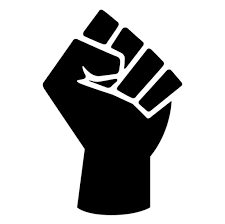
| Laurel Rd, Leicester LE2 1BN |
The Black People's Liberation Party was a group within the community whose objectives were to teach young African Caribbean men about their heritage, culture as well as teaching them about the support systems within the community. They were based on Laurel road, Highfields.
The Black People's Liberation Party published a magazine called Black Chat, which became a vehicle for disseminating information through the black community. One of the legacies of the Black People's Liberation Party is what would become known as Foundation Hostel. - Opal Arts
The Black People's Liberation Party was a group within the community whose objectives were to teach young African Caribbean men about their heritage, culture as well as teaching them about the support systems within the community. They were based on Laurel road, Highfields.
The Black People's Liberation Party published a magazine called Black Chat, which became a vehicle for disseminating information through the black community. One of the legacies of the Black People's Liberation Party is what would become known as Foundation Hostel. - Opal Arts

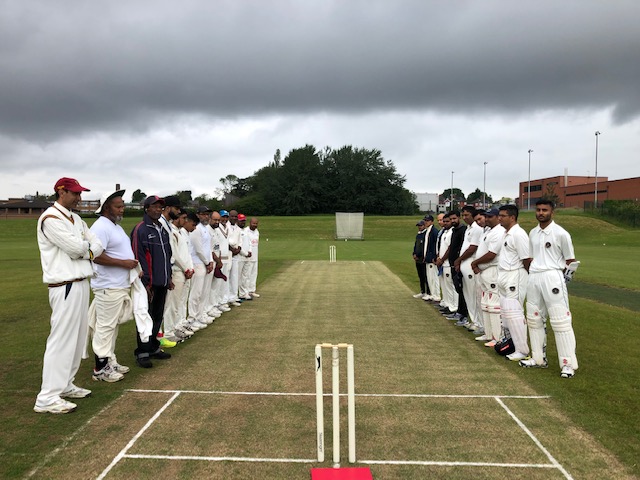
| Ethel Road Playing Fields, Ethel Road, Leicester, LE5 5NA |
The Leicester Caribbean Cricket Club formed in 1957. The club was made up of players from across the colonised Caribbean. The Leicester Caribbean Cricket Club played on Victoria Park for the first 24 years of its existence. In 1981 with support from the Leicestershire County Council and later the Leicester City Council, the club to moved to the site at which they still play today. Ethel Road became home in 1981 and to mark the occasion former West Indian cricket captain Clive Lloyd officially opened the building. - Opal Arts
The Leicester Caribbean Cricket Club formed in 1957. The club was made up of players from across the colonised Caribbean. The Leicester Caribbean Cricket Club played on Victoria Park for the first 24 years of its existence. In 1981 with support from the Leicestershire County Council and later the Leicester City Council, the club to moved to the site at which they still play today. Ethel Road became home in 1981 and to mark the occasion former West Indian cricket captain Clive Lloyd officially opened the building. - Opal Arts

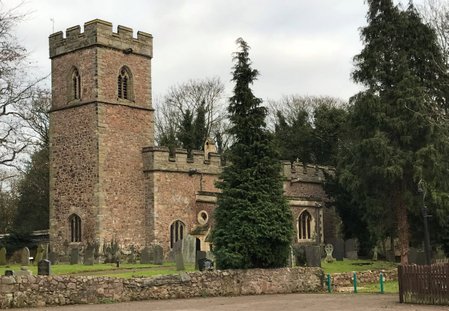
| Church Rd, Wanlip, Leicester LE7 4PJ |
Buried at Our Lady and St Nicholas Church is Rasselas Morjan or Mt Morjan. Born in Abyssinia, he died Wanliip on August 25 1839, when he was only 19 years of age. It is believed that he lived with The Palmers who owned the church at the time and were friends of abolitionist Thomas Babington. Some say that it was in fact Babington that asked the Palmers to take in Rasselas Morjan. The inscription on his tombstone is as follows.
“Sacred To the memory of Rasselas Morjan who was born at Macadi On the continent of Abyssinia and who died at Wanlip hall August 25th 1839 In the 19th year Of his age. Rescued from a state of slavery In this life and enabled by gods grace To become a member of his church he rests here In the hope of a greater deliverance here after This stone is raised in remembrance of his blameless life By one whom he loved.”
Buried at Our Lady and St Nicholas Church is Rasselas Morjan or Mt Morjan. Born in Abyssinia, he died Wanliip on August 25 1839, when he was only 19 years of age. It is believed that he lived with The Palmers who owned the church at the time and were friends of abolitionist Thomas Babington. Some say that it was in fact Babington that asked the Palmers to take in Rasselas Morjan. The inscription on his tombstone is as follows.
“Sacred To the memory of Rasselas Morjan who was born at Macadi On the continent of Abyssinia and who died at Wanlip hall August 25th 1839 In the 19th year Of his age. Rescued from a state of slavery In this life and enabled by gods grace To become a member of his church he rests here In the hope of a greater deliverance here after This stone is raised in remembrance of his blameless life By one whom he loved.”

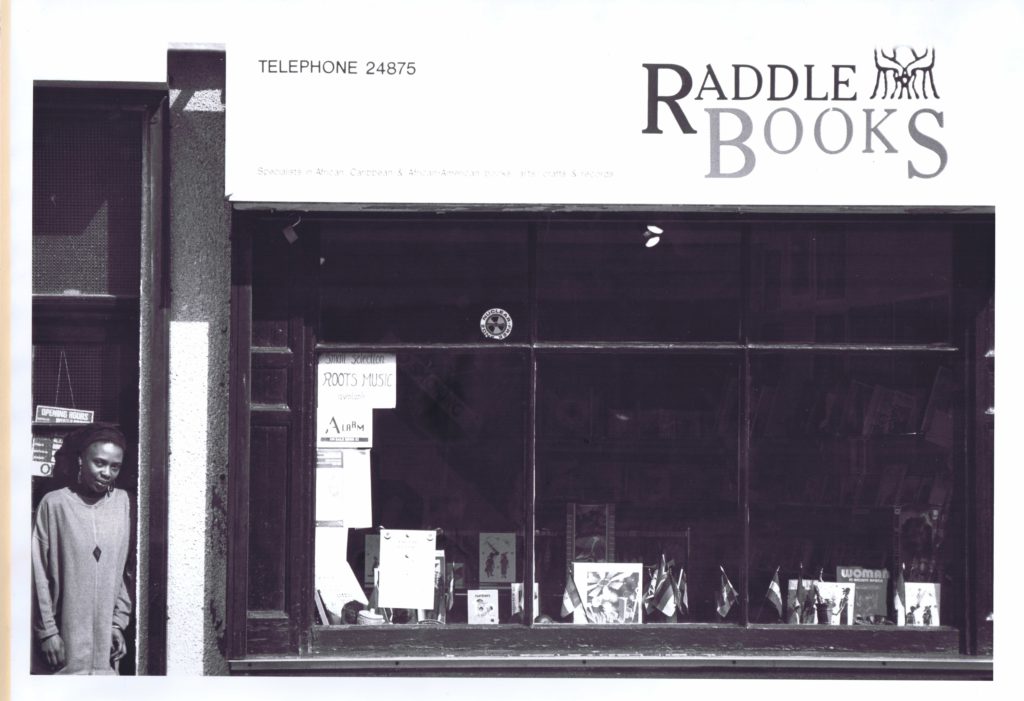
| 52 Berners St, Leicester, LE2 0AF |
Opening its doors in 1979 on Maidstone Road, Raddle Books, was a Black-run collective. The radical bookstore was founded by activist Wolde Selassie and sold, among its diverse collection, Black-orientated literature in the shop. The offering included pamphlets, cookbooks, biographies, academic articles and children's books. The venue played host to discussions on politics, economics, employment and music. Raddle Books was the first meeting place for the Education of the Black Child conference. Unable to acquire funding, the shop closed in the late '90s. Although the shop only ran for about 20 years it helped educate Black people in the East Midlands about their culture and history through their self-funded initiatives such as the Saturday School Project, which was an eight-week project which educated children about Black history.
Opening its doors in 1979 on Maidstone Road, Raddle Books, was a Black-run collective. The radical bookstore was founded by activist Wolde Selassie and sold, among its diverse collection, Black-orientated literature in the shop. The offering included pamphlets, cookbooks, biographies, academic articles and children's books. The venue played host to discussions on politics, economics, employment and music. Raddle Books was the first meeting place for the Education of the Black Child conference. Unable to acquire funding, the shop closed in the late '90s. Although the shop only ran for about 20 years it helped educate Black people in the East Midlands about their culture and history through their self-funded initiatives such as the Saturday School Project, which was an eight-week project which educated children about Black history.


| 433 Gleneagles Ave, Leicester LE4 7YH |
Highfields Rangers is a Football Club and later a Cricket Club first established in 1971. The team was set up in Highfields by Caribbean migrants and their children. The football club first played at Humberstone Park, in 1982 they secured the Gleneagles Avenue site they occupy until this day. In 1977 The Team was escorted from Market Harborough by the police as a game soured after racial slurs and a hostile environment was delivered by the opposing team. In 1986 the Highfields Rangers held their first annual Fun Day, an event that still takes place today. - Opal Arts
Highfields Rangers is a Football Club and later a Cricket Club first established in 1971. The team was set up in Highfields by Caribbean migrants and their children. The football club first played at Humberstone Park, in 1982 they secured the Gleneagles Avenue site they occupy until this day. In 1977 The Team was escorted from Market Harborough by the police as a game soured after racial slurs and a hostile environment was delivered by the opposing team. In 1986 the Highfields Rangers held their first annual Fun Day, an event that still takes place today. - Opal Arts

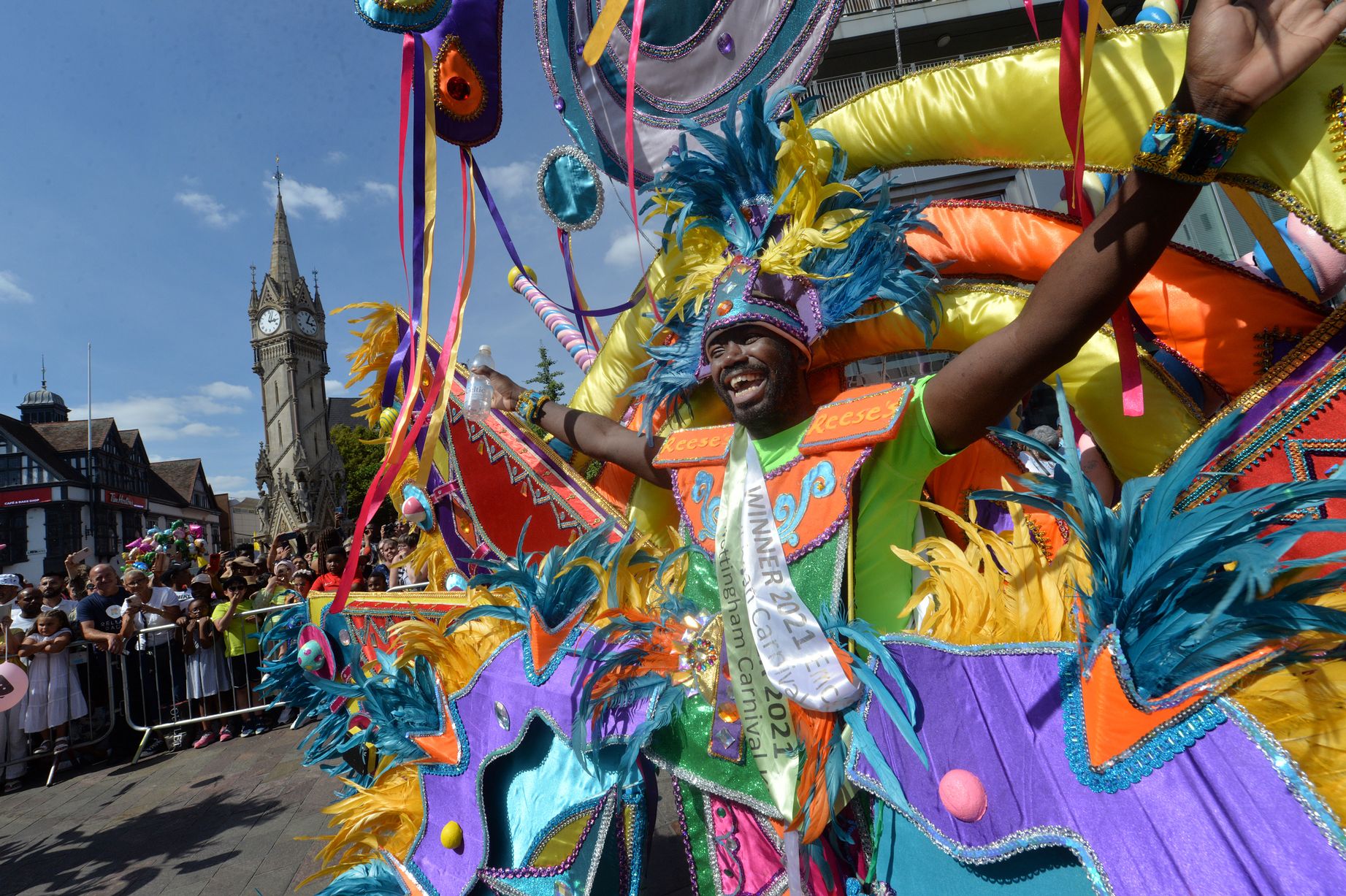
| 2 Elizabeth St, Leicester, LE5 4FL |
Leicester’s Caribbean Carnival was first held in 1985 and has since gone on to become one of the largest Caribbean Carnivals outside of London. The idea to host a carnival of Caribbean culture in Leicester first began in the early 80s. It was hoped it could be a tool that would inspire artistic expression and cultural understanding for the people of Leicester. Born on the island of Nevis, Elvy Morton, one of the founders of the carnival had hoped the festival would help unite people and enable integration between those who had immigrated, such as herself in 1961, and those who already lived in Leicester. In celebration of the historical Caribbean emancipation of enslaved people on August 1, 1834, the festival is held on the first Saturday of August every year.
Leicester’s Caribbean Carnival was first held in 1985 and has since gone on to become one of the largest Caribbean Carnivals outside of London. The idea to host a carnival of Caribbean culture in Leicester first began in the early 80s. It was hoped it could be a tool that would inspire artistic expression and cultural understanding for the people of Leicester. Born on the island of Nevis, Elvy Morton, one of the founders of the carnival had hoped the festival would help unite people and enable integration between those who had immigrated, such as herself in 1961, and those who already lived in Leicester. In celebration of the historical Caribbean emancipation of enslaved people on August 1, 1834, the festival is held on the first Saturday of August every year.

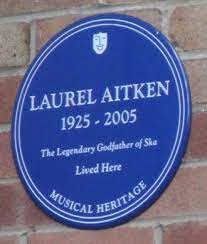
| Munnings Close, St Marks |
Jamaican musician legend Laurel Aitkins, considered the ‘Godfather of Ska’, lived here. The plaque was erected on recommendation by Jamaican High Commissioner Johnson who described Aitkins as a pioneer of modern Jamaican music. Born on 22nd April 1927, Lorenzo 'Laurel' Aitken spent the first eleven years of his life on the island before moving with his family to Kingston, Jamaica, where his developing taste in popular music was further shaped by local
Caribbean sounds, along with the American R&B and Jazz records broadcast by US radio stations and played at the island's clubs and sound system dances. Throughout his adolescence, Laurel worked on his singing and dancing techniques, honing his skills performing for visiting tourists. - Opal Arts
Jamaican musician legend Laurel Aitkins, considered the ‘Godfather of Ska’, lived here. The plaque was erected on recommendation by Jamaican High Commissioner Johnson who described Aitkins as a pioneer of modern Jamaican music. Born on 22nd April 1927, Lorenzo 'Laurel' Aitken spent the first eleven years of his life on the island before moving with his family to Kingston, Jamaica, where his developing taste in popular music was further shaped by local
Caribbean sounds, along with the American R&B and Jazz records broadcast by US radio stations and played at the island's clubs and sound system dances. Throughout his adolescence, Laurel worked on his singing and dancing techniques, honing his skills performing for visiting tourists. - Opal Arts

Login or Register to track the Globes you visit for chance to win a FREE copy of The World Reimagined book!
Find Out More


Artist Globe |
Learning Globe |
Points of Interest |